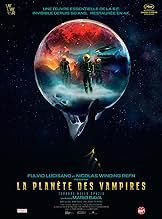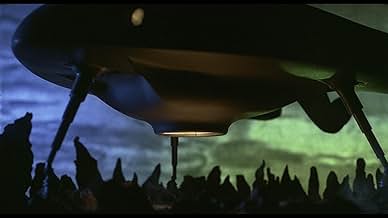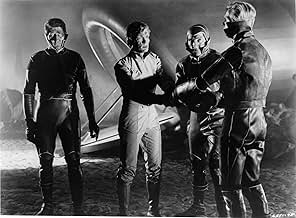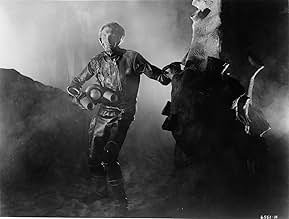AVALIAÇÃO DA IMDb
6,2/10
7,8 mil
SUA AVALIAÇÃO
Adicionar um enredo no seu idiomaAfter landing on a mysterious planet, a team of astronauts begin to turn on each other, swayed by the uncertain influence of the planet and its strange inhabitants.After landing on a mysterious planet, a team of astronauts begin to turn on each other, swayed by the uncertain influence of the planet and its strange inhabitants.After landing on a mysterious planet, a team of astronauts begin to turn on each other, swayed by the uncertain influence of the planet and its strange inhabitants.
- Direção
- Roteiristas
- Artistas
- Prêmios
- 1 indicação no total
Ángel Aranda
- Wess Wescant
- (as Angel Aranda)
Federico Boido
- Keir
- (as Rico Boido)
Vito Fasano
- Dead Galliott Crew Member
- (não creditado)
Giuseppe Mattei
- Brent
- (não creditado)
Avaliações em destaque
23 May 2008. Fourteen years after "The Planet of Vampires" (aka Demon Planet), Ridley Scott would create one of the most frightening and densely layered science fiction/horror films in history that he titled, "Alien." The strong suggestive set design and atmospheric elements from "The Planet of the Vampires" would re-appear in "Alien." Script plots from the original Star Trek television series that began its run in 1966, two years before, are nicely incorporated into this serious attempt at science fiction/horror. While obviously outdated by time, the eerie, alien sounds and visual designs are outstanding for its time. Overall, this movie stands the test of time for its power, its emotional, visceral impact on the senses and its delivery. Eight out of Ten Stars.
Astronauts land on a mysterious planet and encounter many strange and dangerous things--like bodies that don't stay dead.
This Italian movie has horrendous dubbing (except for American Barry Sullivan), silly "special" effects and truly laughable, comic book level dialogue. But it's still worth seeing.
Director Mario Bava was a master at creating spooky atmospheres out of no budget. This was a VERY low budget film (it shows), but he covers it up with beautiful, inventive lighting, tons of dry ice and a really scary score. Also the astronauts wear tight leather outfits which are interesting and some of the Italian guys give good performances--Sullivan is horrible and the women are beyond belief. Also the film contains a few nice jolts and some very scary coming back from the dead sequences.
So, ignore the lousy dialogue and preposterous plot and concentrate on the visuals and sounds. Perfect late night viewing.
This Italian movie has horrendous dubbing (except for American Barry Sullivan), silly "special" effects and truly laughable, comic book level dialogue. But it's still worth seeing.
Director Mario Bava was a master at creating spooky atmospheres out of no budget. This was a VERY low budget film (it shows), but he covers it up with beautiful, inventive lighting, tons of dry ice and a really scary score. Also the astronauts wear tight leather outfits which are interesting and some of the Italian guys give good performances--Sullivan is horrible and the women are beyond belief. Also the film contains a few nice jolts and some very scary coming back from the dead sequences.
So, ignore the lousy dialogue and preposterous plot and concentrate on the visuals and sounds. Perfect late night viewing.
The spaceships Argos commanded by Captain Mark Markary (Barry Sullivan) and her sister Galliot commanded by Captain Sallas (Massimo Righi) travel to the mysterious planet Aura to investigate a strange transmission of a distress signal. The spaceships are protected by the meteor rejector instrument but on the arrival, the gravity increases and the automatic controls go haywire and the Galliot crashes on the surface of Aura. Then the crew-members in Argos go crazy and attack each other in a first moment. Soon Captain Mark finds that most of the crew from Argos is dead after fighting against each other. When the dead members resurrect, Captain Mark, communications officer Sanya (Norma Bengell) and engineer Wess (Ángel Aranda) discover that parasite bodiless aliens have entrapped them with the transmission expecting to flee from their dying world. What will be their attitude?
"Terrore nello spazio", a.k.a. "Planet of the Vampires", despite the low- budget, is an original, stylish and with a surprising plot point. The conclusion shows a great surprise to the viewer. This movie was certainly the major influence to at least Ridley Scott's "Alien" and "Prometheus" that have similar storyline. It was said that the set was a Tower of Babel, with international cast using their own native language (Barry Sullivan, English; Norma Bengell, Portuguese; Ángel Aranda, Spanish; and Evi Marandi, English). My vote is seven.
Title (Brazil): "O Planeta dos Vampiros" ("The Planet of the Vampires")
"Terrore nello spazio", a.k.a. "Planet of the Vampires", despite the low- budget, is an original, stylish and with a surprising plot point. The conclusion shows a great surprise to the viewer. This movie was certainly the major influence to at least Ridley Scott's "Alien" and "Prometheus" that have similar storyline. It was said that the set was a Tower of Babel, with international cast using their own native language (Barry Sullivan, English; Norma Bengell, Portuguese; Ángel Aranda, Spanish; and Evi Marandi, English). My vote is seven.
Title (Brazil): "O Planeta dos Vampiros" ("The Planet of the Vampires")
I saw this film in it's 1965 American release, and at the time I was not overly impressed. It was obviously made on a low budget, the dialog dubbing is bad (although far superior to some other Italian imports I have seen), the acting alternates between wooden (Barry Sullivan) and outrageously overdone (i.e., "gravity effects", the reaction of the actor who smashes the "meteor deflector", numerous fear reaction shots of crew members). Time has proven that it has become a trend setter for numerous subsequent sci-fi films (most notably Ridley Scott's "Alien" (1979)). I recently viewed it again 37 years after it's release, and the similarities to "Alien" are unmistakable. The attentions of the crews of both films are attracted by mysterious radio signals originating from an unexplored world. The horseshoe shape of the ships in POTV resembles that of the wrecked alien spacecraft in "Alien". There are similar shots of the ship's landing gear in both films. Both crews find ancient wrecked spacecraft and skeletal remains of giant aliens on the planets they land upon. There is an unknown predatory alien presence in both films. Lots of gore footage exists in both films too, although POTV unarguably started this trend (alas, is there any recent sci-fi film that does not fall to this temptation?).I cannot believe that all these similarities are coincidental, and I suspect that Dan O'Bannon must have been heavily influenced by POTV, whether he realized it or not.
The use of lighting and color are also noteworthy. POTV still looks good today due to colorful exterior scenes (forgive the somewhat clumsy use of composite shots of the crew in a few scenes set against an obviously miniature landscape). Please also forgive the overzealous use of the zoom lens, which had just been developed at the time. One big demerit in set design comes from a scene inside the wrecked alien spacecraft. A prominently-featured prop appears to be the taillight lens from a 1957 Packard, complete with the backup light lens below it. It is positioned vertically in the shot, and perhaps the set designer was hoping that Italian audiences would not recognize it. Another detractor is the almost unlimited amount of area inside the ships. No ceilings are visible, and the various compartments look as big as football fields when compared to realistic spacecraft design criteria.
I found this to be an entertaining if somewhat flawed film, certainly more enjoyable than it was when I first watched it in 1965. It deserves a vote of 6/10.
The use of lighting and color are also noteworthy. POTV still looks good today due to colorful exterior scenes (forgive the somewhat clumsy use of composite shots of the crew in a few scenes set against an obviously miniature landscape). Please also forgive the overzealous use of the zoom lens, which had just been developed at the time. One big demerit in set design comes from a scene inside the wrecked alien spacecraft. A prominently-featured prop appears to be the taillight lens from a 1957 Packard, complete with the backup light lens below it. It is positioned vertically in the shot, and perhaps the set designer was hoping that Italian audiences would not recognize it. Another detractor is the almost unlimited amount of area inside the ships. No ceilings are visible, and the various compartments look as big as football fields when compared to realistic spacecraft design criteria.
I found this to be an entertaining if somewhat flawed film, certainly more enjoyable than it was when I first watched it in 1965. It deserves a vote of 6/10.
Mario Bava does it again. The crystal colours, eerie atmosphere and evocative visuals are downright dazzling and haunting in this low-budget Italian Sci-fi outing. Never have I been disappointed in these technical aspects while experiencing the master at work. Many have mentioned it and the influences / similarities to Ridley Scott's 'Alien (1979)' ultimately sticks out. Even with that in mind it does share some ideas with the body snatcher theme, but it was a cleverly done concept done in a slow grinding, but extremely engaging style. The pacing is slow, but the flashy imagery and smoothly placed camera-work was hypnotic that it helped time flow by. My only real gripe was that the script was on the stilted side, but other than that it was one of those subtlety breezy mood pieces. More often the deaths happen off-screen and it's mostly free of action, to really only hit in the dying stages in some rapid set-pieces, but it's the dreary ending that's a strike of genius. Bava's crisp direction lets the otherworldly Gothic vibe take hold and while the sterile set designs look cheap it manages to be effective in its unusually stylish looks (add in seeping fog) and this invokes brooding unease and alienation. The surrounding sound effects and music score are creepily orchestrated. As for the special effects/make-up FX for such a low-cost production, they were well executed and ideally used. The acting can be rather rough in a staged sense with a dependable Barry Sullivan heading the way. Some of the characters were hard to tell apart though. A marvellously old-fashion, but influentially chilling space expedition.
Você sabia?
- CuriosidadesThis film marks the first collaboration between Mario Bava and his son/assistant director Lamberto Bava. Lamberto would later become a director himself.
- Erros de gravaçãoWhen Toby and Mark duke it out, Toby bumps into and moves the flight seat revealing it to be unattached to the deck.
- Citações
Capt. Mark Markary: I'll tell you this, if there 'are' any intelligent creatures on this planet... they're our enemies.
- Versões alternativasThe original Italian version runs 88 minutes long. The US version runs 86 minutes long.
- ConexõesFeatured in Aweful Movies with Deadly Earnest: The Demon Planet (1969)
Principais escolhas
Faça login para avaliar e ver a lista de recomendações personalizadas
Detalhes
- Data de lançamento
- Países de origem
- Idiomas
- Também conhecido como
- El planeta de los vampiros
- Locações de filme
- Empresas de produção
- Consulte mais créditos da empresa na IMDbPro
Bilheteria
- Orçamento
- US$ 200.000 (estimativa)
- Tempo de duração
- 1 h 28 min(88 min)
- Mixagem de som
- Proporção
- 1.66 : 1
Contribua para esta página
Sugerir uma alteração ou adicionar conteúdo ausente




























